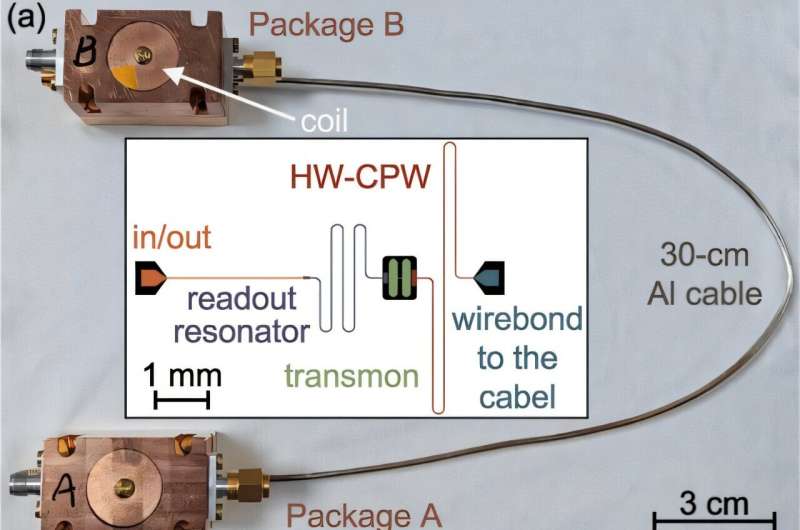Quantum computers hold the potential of solving some optimization and data processing problems that cannot be tackled by classical computers. Many of the most promising quantum computing platforms developed so far are based on superconducting qubits, tiny circuits based on superconducting materials.
Despite their good performance, most superconducting quantum processors still exhibit significant limitations that prevent their upscaling and deployment. These include frequency crowding (i.e., an interference between multiple qubits with overlapping resonance frequencies) and difficulties associated with the control or measurement of several qubits.
To overcome these limitations, some physicists and engineers have been exploring the possibility of realizing distributed quantum computing, which entails the connection between several smaller processors that act as one larger system. This would require the establishment of so-called entangling gates, instructions that simultaneously act on two or more qubits and link them via the quantum mechanical effect known as entanglement.
Researchers at the Beijing Academy of Quantum Information Sciences and the Chinese Academy of Sciences recently introduced a new approach to create high-fidelity entangling gates between two distant superconducting quantum processors. In a recent paper, published in Physical Review Letters, they reported the realization of high-fidelity entangling gates between two processors that were 30 cm apart.
“This work originated from a question posed by Dr. Fei Yan (one of the co-authors) last year,” Wen-Gang Zhang, co-author of the paper, told Phys.org. “He asked, ‘Can we realize a two-qubit entangling gate between two remote quantum chips?’
“As noted in the paper, remote connections between quantum chips have been demonstrated previously. However, these implementations invariably relied on quantum state transfer (QST), a process inherently unsuitable for circuit-based quantum computing. In other words, QST cannot directly enable universal quantum computation.”
The main objective of the team’s recent study was to overcome the limitations of QST-based approaches for realizing entangling gates between remote quantum chips. Notably, the researchers were able to realize two widely utilized two-qubit entangling gates, known as CNOT and CZ.
“We realized the two-qubit entangling gates (perfect entangler) utilizing the cross-resonance effect,” explained Zhang. “The effect is widely used for realizing entangling gates between superconducting qubits which are nearby on the same chip. In those works, the qubits are coupled by capacitors between them. Our idea is that the linear harmonic oscillator can also be used to couple two qubits, and a long microwave cable can be regarded as a microwave cavity.”

As part of their study, the researchers explored the possibility of using a microwave cable to couple remote qubits. Subsequently, they leveraged an effect known as the ‘cross effect’ to realize their desired entangling gates.
“This work demonstrates the first direct two-qubit gate between different quantum chips with such high fidelity,” said Zhang. “Notably, the protocol is remarkably simple to implement, requiring no additional qubits or control lines. We believe this will be a crucial building block for distributed quantum computing.”
This recent work by Zhang and his colleagues could soon open new exciting possibilities for the realization of universal and distributed quantum information processing. In the future, the methods employed as part of this study could also be used to couple qubits in the same quantum chip, potentially also enabling the implementation of quantum LDPC error correction codes (i.e., codes designed to detect and correct errors made by quantum computers).
“So far, we realized a simple demonstration of the two-qubit entangling gate between two remote chips,” added Zhang. “In the future, we plan to fabricate some larger chips which contain ~100 qubits and entangle them together to finally achieve the goal of distributed quantum computing. Also, the microwave cable is wire-bonded onto the chip. We want to make it plug-in and play so that we can substitute one of the chips without taking the whole system off the dilution fridge.”
Written for you by our author Ingrid Fadelli, edited by Gaby Clark, and fact-checked and reviewed by Robert Egan—this article is the result of careful human work. We rely on readers like you to keep independent science journalism alive.
If this reporting matters to you,
please consider a donation (especially monthly).
You’ll get an ad-free account as a thank-you.
More information:
Juan Song et al, Realization of High-Fidelity Perfect Entanglers between Remote Superconducting Quantum Processors, Physical Review Letters (2025). DOI: 10.1103/npr7-b7kq.
© 2025 Science X Network
Citation:
High-fidelity entangling gates connect remote superconducting quantum processors (2025, August 24)
retrieved 25 August 2025
from
This document is subject to copyright. Apart from any fair dealing for the purpose of private study or research, no
part may be reproduced without the written permission. The content is provided for information purposes only.

